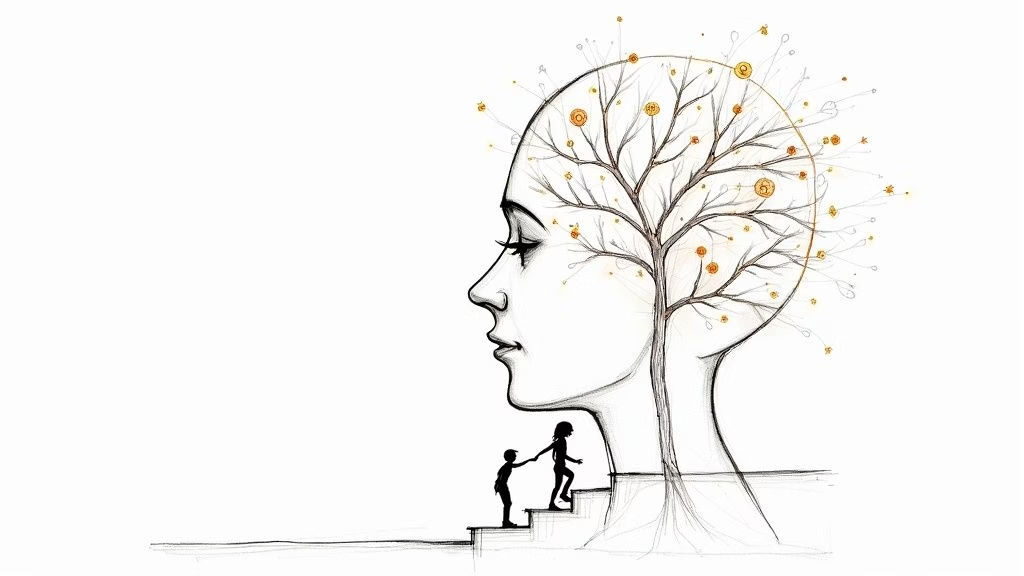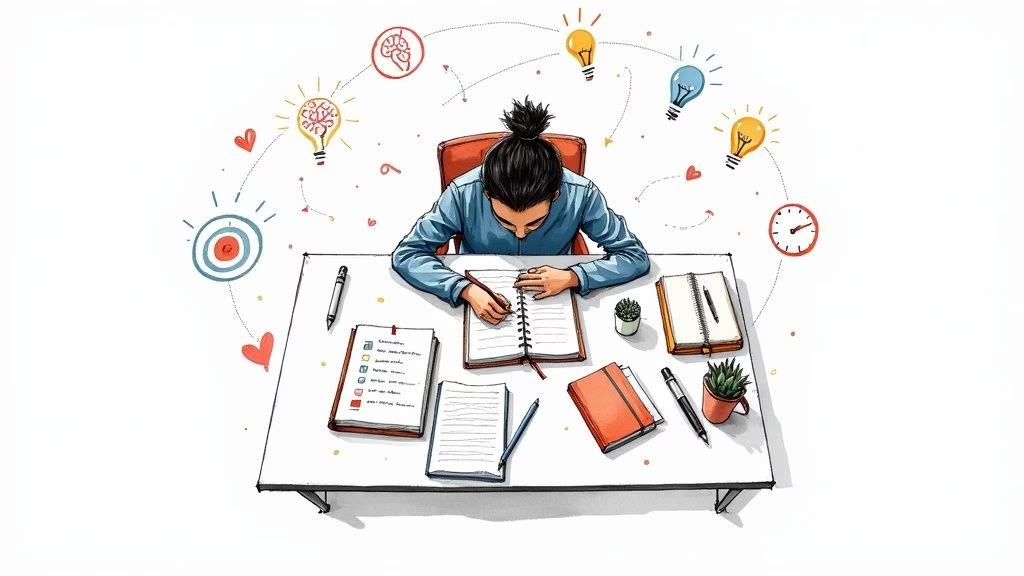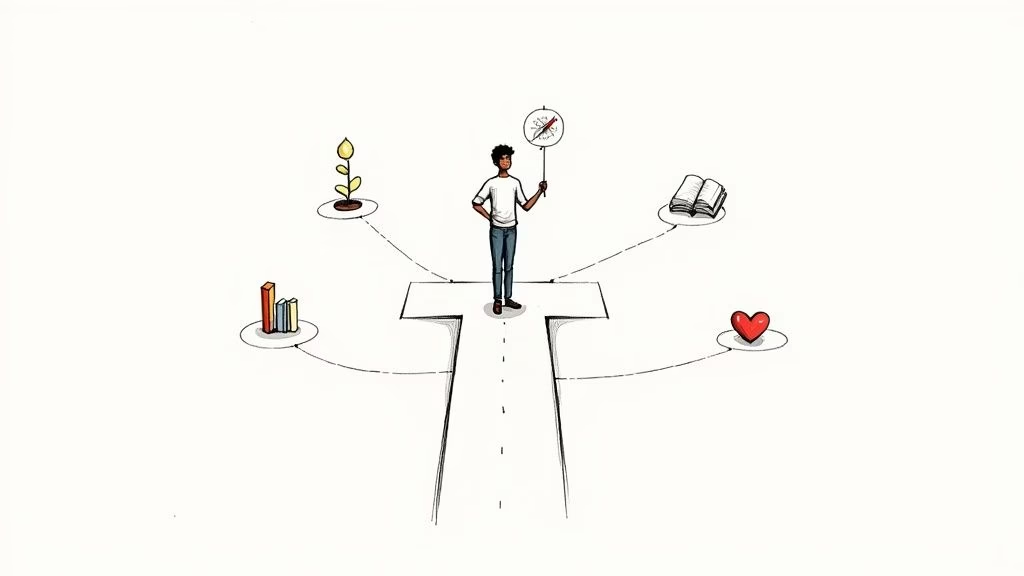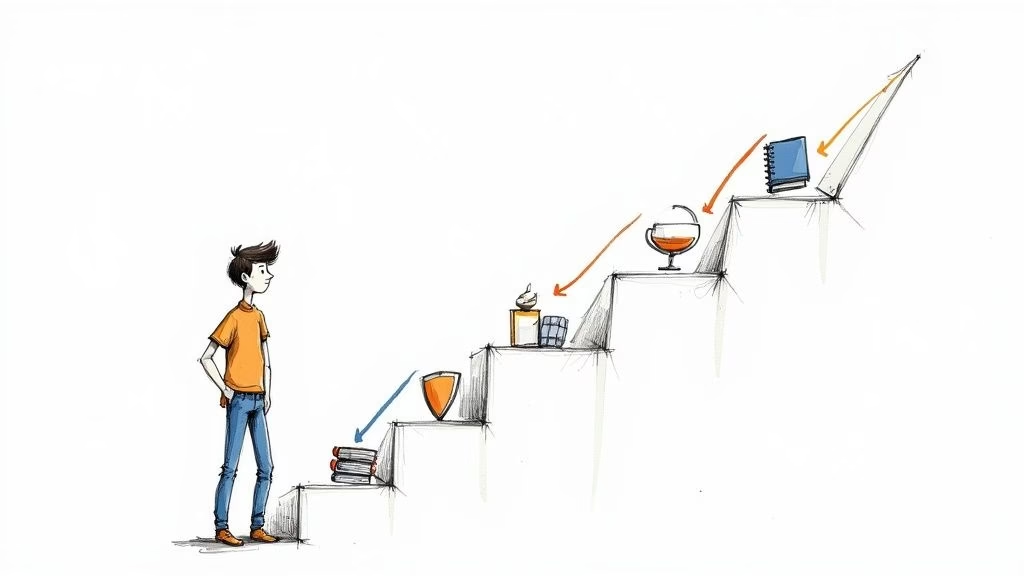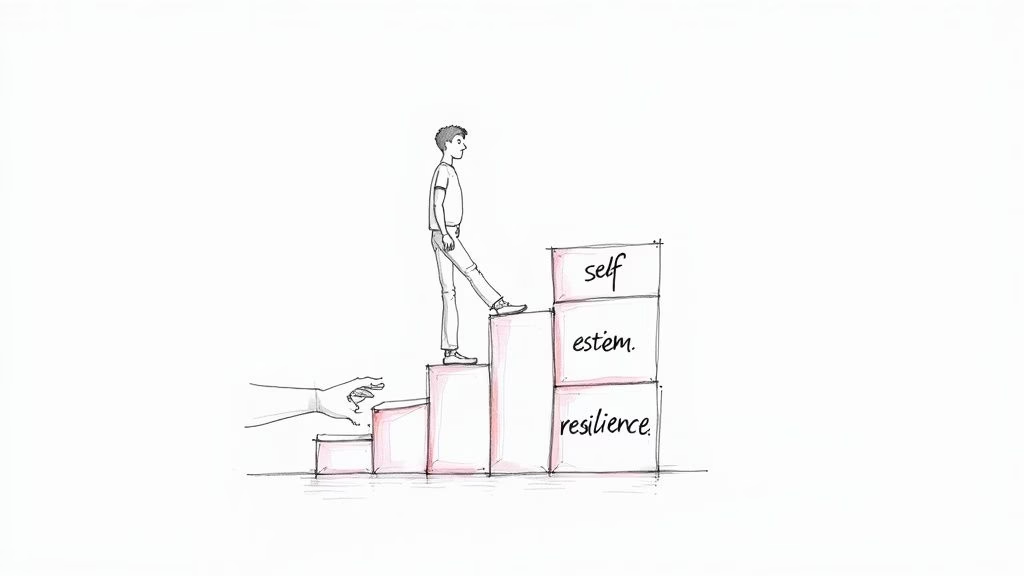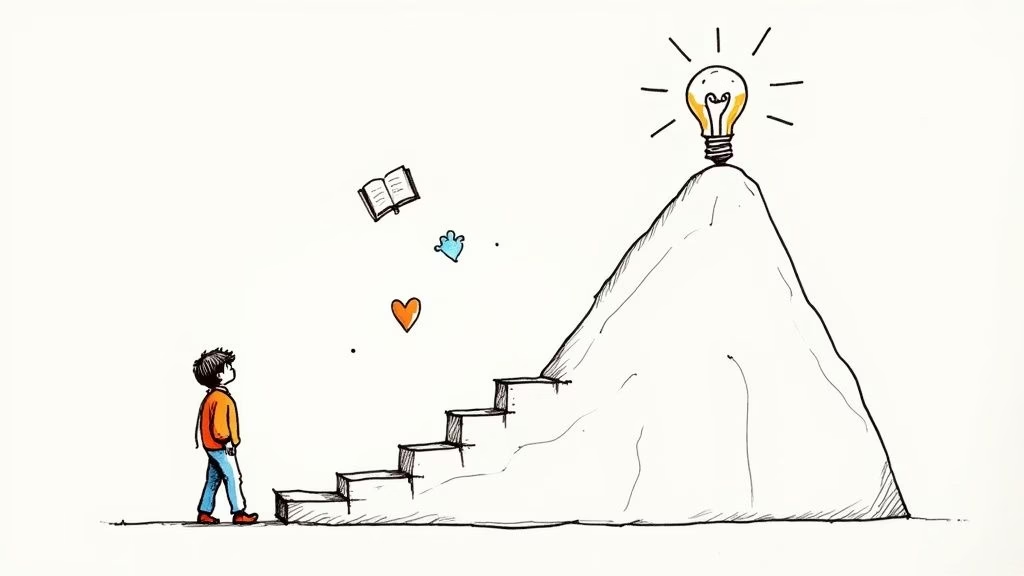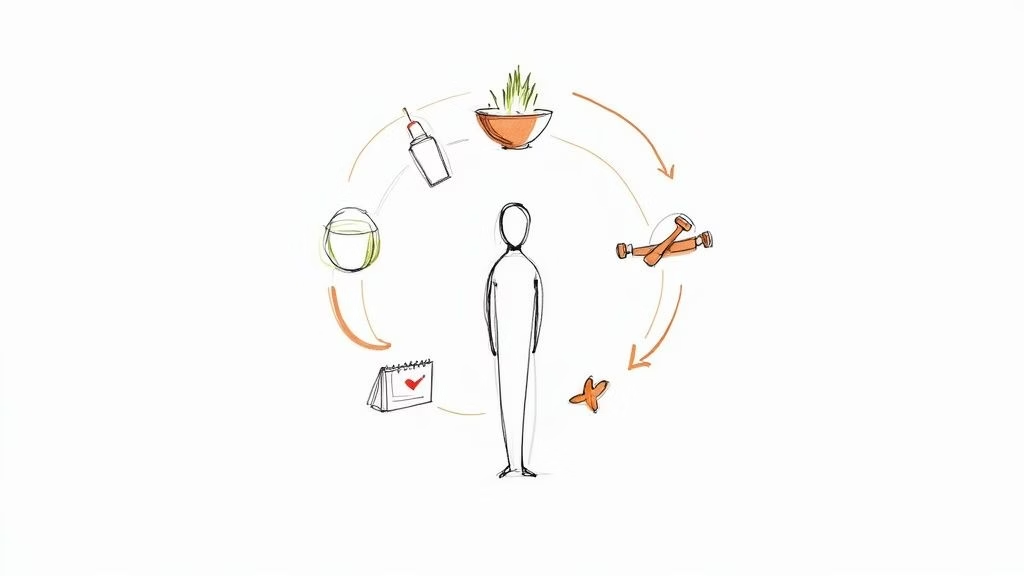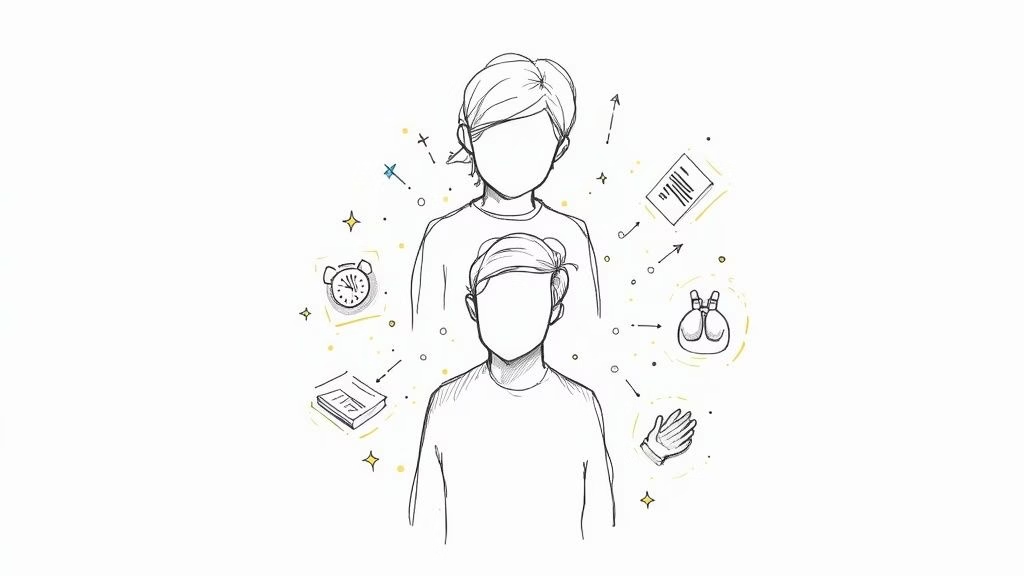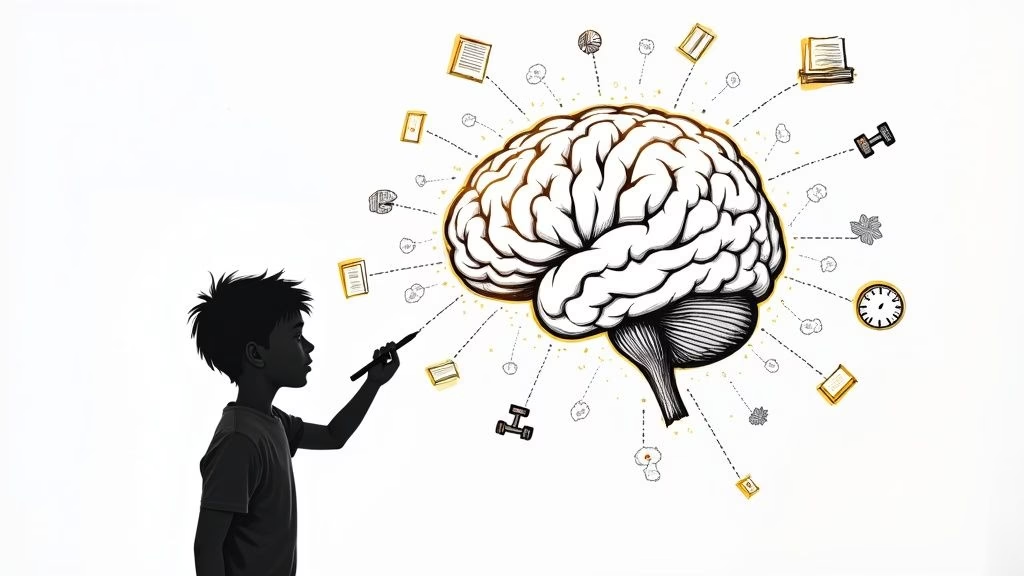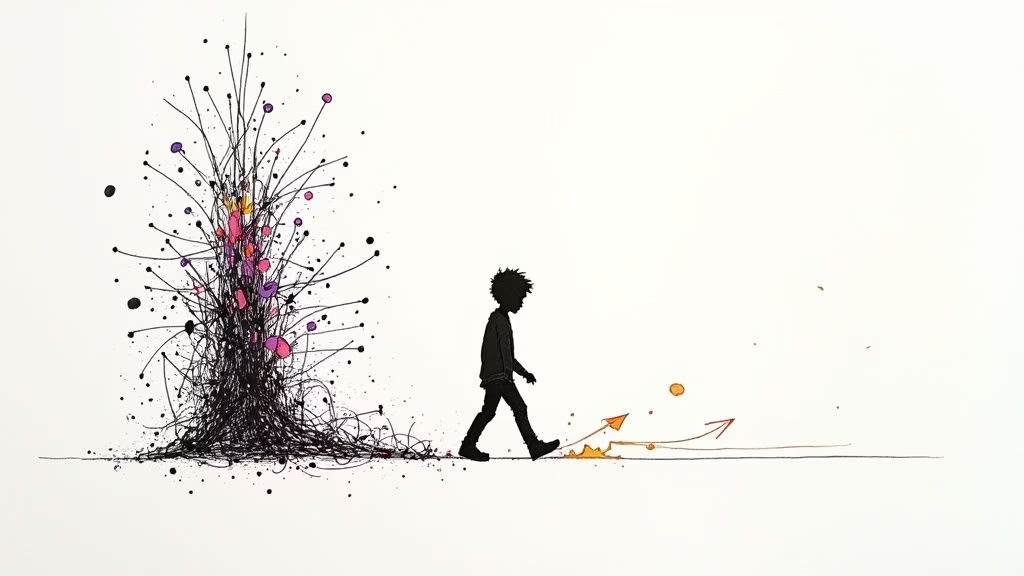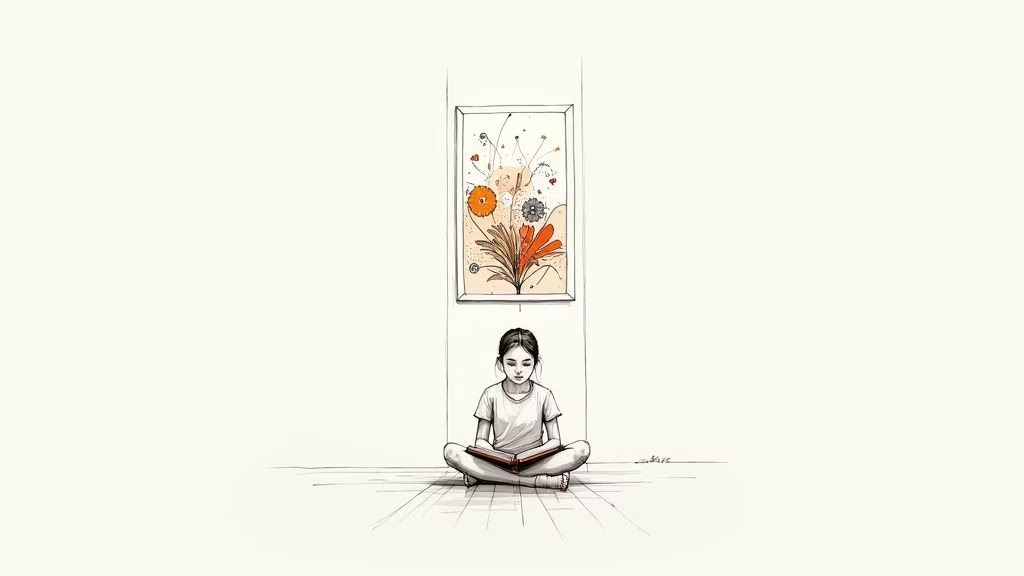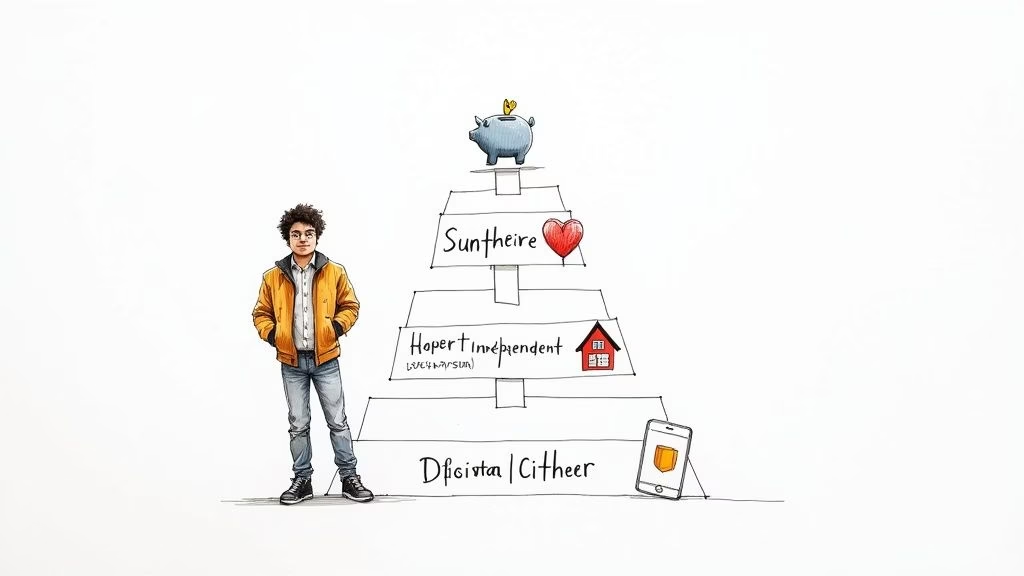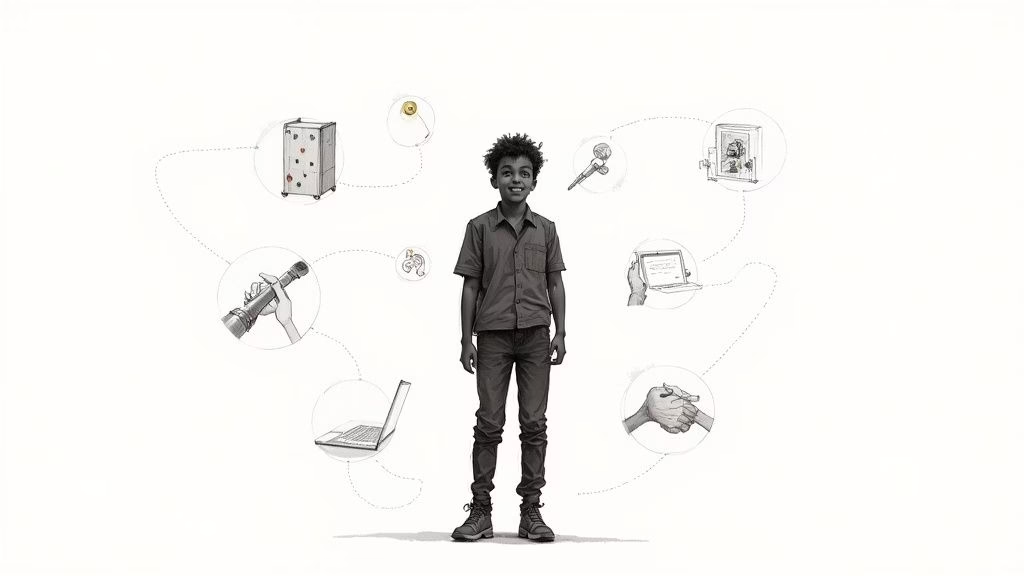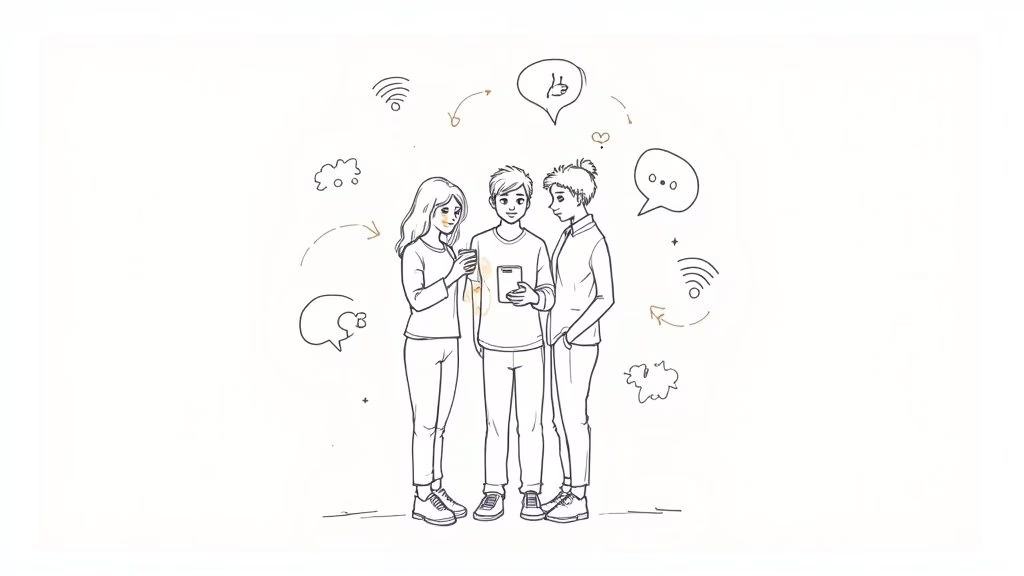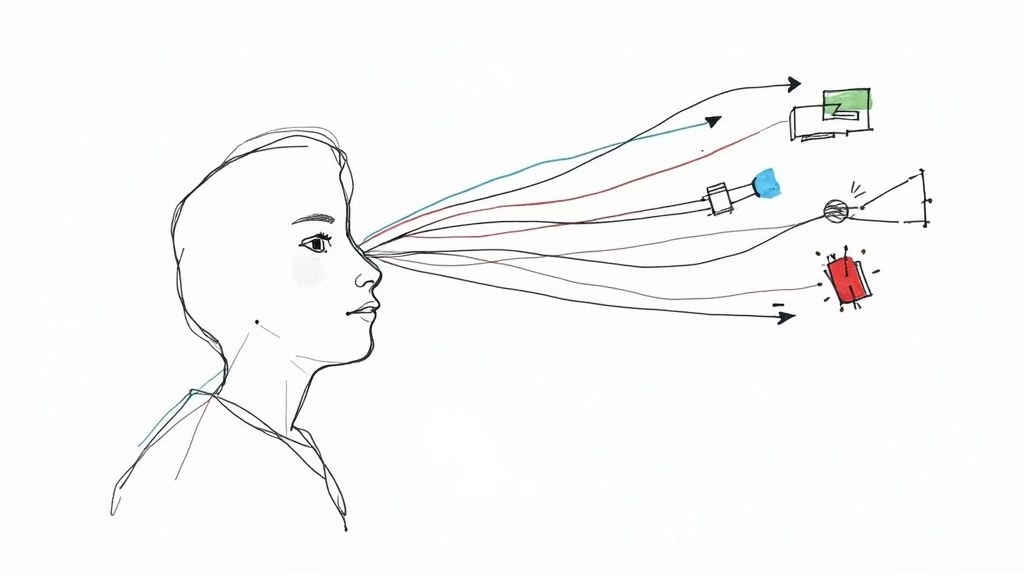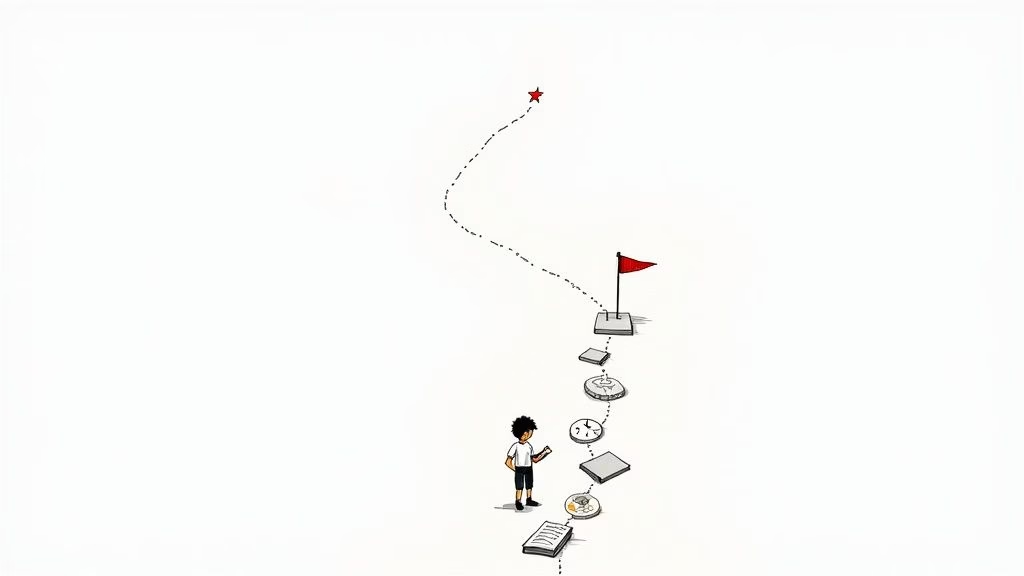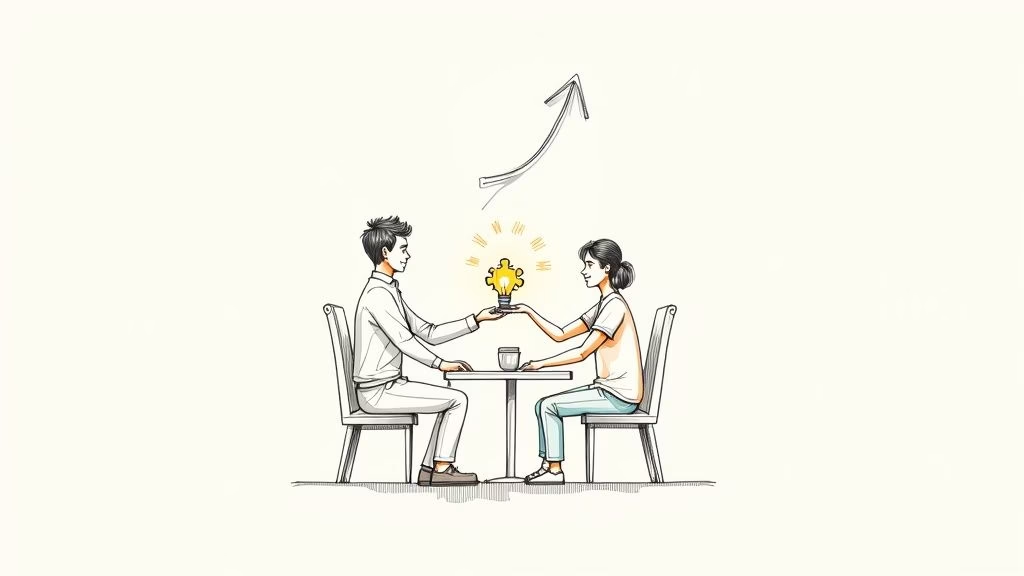Navigating the teenage years is a complex journey for both teens and parents. Academic pressure, social challenges, and the struggle with motivation can often lead to procrastination and a dip in self-esteem. For many, especially teen boys who may feel pressure to conform to specific molds, finding a constructive outlet can feel overwhelming. This guide offers a comprehensive look at powerful confidence building activities for teenager development, specifically designed to foster resilience, motivation, and a strong sense of self-worth.
We will explore practical, actionable strategies that go beyond surface-level advice. You will find specific implementation details for each activity, from public speaking to volunteer work, tailored to engage and empower your teen. This article incorporates crucial parenting tips, valuable mental health resources, and unique approaches to help your teen thrive academically and personally.
These activities are not just pastimes; they are tools to build a foundational confidence that will support them through high school, college applications, and into their early careers. We provide the blueprint for you to help them unlock their potential, manage stress, and build lasting self-assurance.
1. Master the Stage: Public Speaking and Presentation Skills
Public speaking is one of the most common fears, yet it's also one of the most powerful confidence-building activities for a teenager. This activity involves creating structured opportunities for teens to practice expressing their ideas verbally in front of others. It goes beyond formal presentations to include impromptu speaking exercises, storytelling, and debate, systematically building confidence by gradually increasing the challenge in a supportive environment.

The core benefit is conquering a significant fear through competence. As a teen researches a topic, organizes their thoughts, and delivers a coherent message, they develop a profound sense of mastery and self-efficacy. This newfound confidence often extends beyond the stage, helping them articulate their needs better with family, participate more in class, and handle social situations with greater ease. Programs like Toastmasters Youth Leadership and the National Speech & Debate Association provide excellent frameworks for this growth.
How to Implement This Activity
For parents looking to support their teen, start small to avoid overwhelm, which can fuel procrastination. Begin with low-stakes scenarios before moving to more formal settings.
- Start at Home: Encourage your teen to present a topic they are passionate about-like a video game strategy or a movie analysis-to the family.
- Use Technology: Have them record themselves practicing. This self-review process is a private, low-pressure way to identify areas for improvement.
- Join a Club: Look for school clubs or community programs like Model UN or a debate team. These provide a structured and peer-supported environment for practice.
Key to Success: Gradual Exposure and Support
The goal isn't instant perfection but gradual improvement. Celebrate small victories, like speaking for one minute without notes or making eye contact with the audience. To help your teen truly 'master the stage' and build their assertiveness, exploring proven strategies for overcoming public speaking anxiety and speaking with confidence can be incredibly beneficial. For a deeper dive into how this skill translates into daily life, you can explore more about enhancing communication skills for teens.
2. Goal Setting and Achievement Tracking
Goal setting is a systematic approach to helping teenagers identify, plan, and accomplish personal objectives. This activity teaches teens to break down large aspirations into manageable, actionable steps, create a clear plan, and track their progress over time. The process builds confidence not through wishful thinking, but through the tangible evidence of consistent achievement and self-discipline, developing crucial life skills like planning, resilience, and self-motivation.

The core benefit of this confidence building activity for a teenager is the development of an internal locus of control. When teens see a direct link between their effort and their results, they feel more in command of their lives, which directly combats feelings of helplessness and anxiety. This skill is critical for overcoming academic procrastination, improving school performance, and managing the stress of college applications. Youth development organizations like the Boys & Girls Clubs and high school athletic programs have successfully used these frameworks to boost both performance and self-esteem.
How to Implement This Activity
For parents helping a teen, the key is to facilitate their process rather than dictate their goals. The motivation must come from their own aspirations to be sustainable.
- Start Small and Specific: Begin with a small, easily achievable goal, like organizing their desk or finishing a homework assignment a day early. This builds momentum.
- Make it Visual: Use a journal, a whiteboard, or a goal-tracking app to make progress visible. Seeing milestones checked off is highly motivating.
- Focus on Process, Not Just Outcome: Set "process goals" (e.g., study for 30 minutes each night) alongside "outcome goals" (e.g., get a B+ on the test). This emphasizes effort, which they can control.
Key to Success: Connection and Reflection
The most powerful goals are those connected to a teen's personal values and interests. Regularly scheduled, non-judgmental check-ins to reflect on progress and adjust the plan are essential for maintaining motivation. For a comprehensive guide, exploring effective strategies for goal setting for teenagers can provide a structured roadmap. This approach empowers them to turn abstract dreams into concrete realities, building a foundation of confidence that lasts a lifetime.
3. Creative Arts and Performance
Engaging in creative arts such as music, theater, visual arts, or dance is a profoundly effective confidence-building activity for a teenager. This practice provides a vital outlet for self-expression, allowing teens to explore their identity, process complex emotions, and develop unique skills in a low-pressure environment. Whether painting, acting, or writing a song, the arts foster a sense of accomplishment and self-worth derived from personal creation rather than external competition.

The primary benefit is building confidence through creative achievement and skill mastery. When a teen finally plays a difficult piece of music, completes a painting, or performs a role on stage, they gain tangible proof of their ability to learn, persist, and create something valuable. This process improves their focus, reduces procrastination on challenging tasks, and often translates to better academic engagement. Organizations like community art centers and youth orchestras provide structured environments where these skills can flourish, with many participants reporting increased self-esteem and reduced anxiety.
How to Implement This Activity
For parents aiming to support their teen's artistic journey, the key is to encourage exploration without imposing expectations. The goal is to nurture their intrinsic motivation.
- Offer Diverse Options: Introduce various creative outlets. Sign them up for a trial pottery class, rent a musical instrument for a month, or provide access to digital art software.
- Focus on Process, Not Product: Emphasize the enjoyment and learning involved in creating, rather than the perfection of the final piece. This mindset reduces performance anxiety.
- Create Sharing Opportunities: Encourage them to share their work in a supportive setting, such as performing a song for the family or displaying art at home, before moving to public exhibitions or recitals.
Key to Success: Encourage Expression and Experimentation
True confidence comes from finding a medium that resonates with the teen's inner voice. If they show an interest in music, for example, helping them find resources like songwriting tips for beginners can empower them to turn their feelings into art. Celebrate their courage to try new things and express themselves authentically, as this is where lasting self-assurance is built. For a deeper look into how creative outlets support mental well-being, you can find more on the role of art in teen mental health.
4. Leadership Roles and Responsibilities
Taking on leadership roles provides teenagers with a powerful platform to build confidence by making impactful decisions and guiding their peers. This activity involves stepping into positions of responsibility, whether as a team captain, club president, student government representative, or peer mentor. It moves teens from a passive role to an active one, where they learn to organize, delegate, and inspire others, building confidence through tangible achievements and the trust placed in them by their community.

The core benefit of leadership is the development of self-efficacy and a sense of purpose. When a teen successfully organizes a school event or mentors a younger student, they see direct evidence of their competence and positive influence. This experience is a crucial confidence-building activity for teenagers because it demonstrates their capacity to effect change and navigate complex social dynamics. Leadership also hones essential life skills like communication, problem-solving, and empathy, which are vital for academic, personal, and future professional success.
How to Implement This Activity
For parents, encouraging leadership doesn't mean pushing your teen into the spotlight. It's about finding roles that align with their interests and gradually increasing their level of responsibility to avoid overwhelming them.
- Start with Their Passions: If your teen loves video games, they could organize a small local tournament. If they are passionate about environmental issues, they can lead a recycling initiative at school.
- Encourage Peer Mentoring: Programs where older students tutor or mentor younger ones are excellent entry points. This builds confidence by positioning the teen as a knowledgeable guide and role model.
- Look for Formal Opportunities: Encourage them to join established programs like student council, a youth advisory board for a local nonprofit, or a leadership role within a sports team or academic club.
Key to Success: Focus on Service and Growth
The most effective leadership is rooted in service, not authority. Emphasize that a leader's job is to support their team and help others succeed. Celebrate the effort and lessons learned from challenges, not just the successful outcomes. For teens, especially young men who may feel pressured to project an image of infallible strength, learning that true leadership involves vulnerability and learning from mistakes is transformative. Exploring resources on empathetic leadership can help them develop a more authentic and effective style.
5. Physical Fitness and Sports Challenges
Physical fitness and sports challenges are powerful confidence building activities for a teenager, focusing on setting and achieving tangible physical goals. This involves everything from joining a school sports team to completing a personal fitness program like Couch to 5K. The process builds confidence through improved physical capabilities, the discipline of consistent effort, and the resilience learned from pushing past perceived limits. The mind-body connection is central; as a teen's physical strength grows, so does their mental fortitude and self-esteem.
The primary benefit is building self-efficacy through physical achievement. When a teen masters a new skill, runs a longer distance, or contributes to a team victory, they gain concrete proof of their ability to set a goal and accomplish it. This sense of competence directly combats feelings of helplessness and procrastination. For teen boys, in particular, group sports or martial arts can provide a structured outlet and a sense of belonging. The discipline required for regular training also translates into better focus and motivation in school.
How to Implement This Activity
The key is finding an activity that aligns with the teenager's interests and current fitness level to ensure it feels empowering, not punishing.
- Set Realistic, Progressive Goals: Start with a manageable challenge, like walking for 20 minutes three times a week, and gradually increase the intensity.
- Focus on Personal Improvement: Encourage your teen to track their own progress, such as lifting a heavier weight or shaving seconds off their mile time, rather than comparing themselves to others.
- Find the Right Fit: Explore diverse options beyond traditional sports, such as rock climbing, martial arts, yoga, or dance. The goal is consistent movement, not a specific activity.
Key to Success: Consistency and Effort
Celebrate the effort and consistency, not just the final results. Acknowledging the dedication it takes to show up for practice on a tough day is more impactful than only praising a victory. For teenagers new to football, mastering fundamental techniques is key to building self-assurance on the field, and you can find more guidance on this topic with these essential soccer drills for beginners to boost confidence. By focusing on the journey of improvement, teens develop a growth mindset that serves them well beyond the playing field.
6. Volunteer Work and Community Service
Volunteer work involves teenagers in meaningful service that addresses real community needs, fostering a powerful sense of purpose and social responsibility. This activity builds confidence by allowing teens to make a tangible, positive impact on others' lives, develop new practical skills, and gain valuable perspective on their own capabilities and circumstances. It connects personal action to a greater good, showing them they have the power to create change.
The core benefit of community service is the development of empathy and a sense of agency. When a teenager sees the direct result of their effort, whether it's building a home with Habitat for Humanity or tutoring a younger student, they internalize their value and competence. This experience often combats feelings of helplessness and boosts motivation by providing a clear, external purpose. Organizations like VolunteerMatch and DoSomething.org make it easy for teens to find opportunities that align with their passions.
How to Implement This Activity
For parents, the key is to help teens find a cause that genuinely interests them, as this intrinsic motivation is crucial for sustained engagement and combating procrastination.
- Align with Passions: If your teen loves animals, suggest volunteering at a local shelter. If they are passionate about environmental issues, look for park cleanup or conservation projects.
- Start Small and Local: Begin with a one-day event or a short-term project to prevent overwhelm. This makes the commitment feel manageable and provides a quick sense of accomplishment.
- Serve Together: Volunteering as a family can be a powerful bonding experience and provides a built-in support system, which is especially helpful for teens struggling with social anxiety.
Key to Success: Reflection and Responsibility
True confidence comes not just from the act of volunteering but from understanding its impact. Encourage your teen to reflect on what they've learned about themselves and the community. As they become more comfortable, support them in taking on greater responsibility or a leadership role within the organization. For more insights on how these activities foster resilience, you can learn about building mental health in young men and women through purposeful engagement.
7. Social Skills Development and Peer Interaction
Social skills activities focus on improving interpersonal communication, building friendships, and navigating social situations effectively. Through structured social interactions, conflict resolution training, and peer support groups, teens practice reading nonverbal cues and expressing themselves with clarity. As they master small wins—like joining a study group or mediating a classroom dispute—their overall confidence and motivation at school climb, which in turn reduces procrastination and academic anxiety.
What Is Social Skills Development and How It Works
Social skills development uses role-plays, group discussions, and real-world exercises to strengthen conversation, empathy, and teamwork. Teens learn to manage stress through guided meditation sessions before social events, and parents can model active listening during family meetings. This approach stems from research by Dale Carnegie on influence, Daniel Goleman on emotional intelligence, and Brené Brown on vulnerability and connection.
When and Why to Use This Approach
- When teens avoid group projects or feel isolated
- To address low self-esteem triggered by social anxiety
- Before transitions like starting high school or college
- To support teen boys in men’s groups focused on respect, honesty, and peer mentoring
Examples of Successful Implementation
- Social skills groups in schools showing 70% improvement in peer relationships
- Teen leadership camps emphasizing communication and teamwork
- Peer mediation programs reducing school conflicts by 60%
- Drama therapy boosting interaction skills in shy adolescents
- Youth group activities at community centers offering safe practice spaces
Actionable Tips for Parents and Teens
- Practice Active Listening: Encourage teens to ask open-ended questions and summarize what they hear.
- Start Small: Schedule one-on-one coffee chats with peers before larger gatherings.
- Use Meditation Guides: Short breathing exercises calm nerves before social situations and curb procrastination.
- Join Men’s or Boys’ Groups: Teen boys can find peer support and accountability.
- Role-Play Scenarios: Act out common challenges like introducing yourself or handling conflict.
“Repeated positive social experiences fuel self-belief far more than one-off praise,” notes Susan Cain.
Learn more about Social Skills Development and Peer Interaction on domain.com to access worksheets, parenting tips, and mental health resources for teens.
Confidence Building Activities: 7-Point Comparison Guide
| Activity | Implementation Complexity | Resource Requirements | Expected Outcomes | Ideal Use Cases | Key Advantages |
|---|---|---|---|---|---|
| Public Speaking and Presentation Skills | Moderate – requires skilled facilitation and structured practice | Low to Medium – space, facilitators, and feedback tools | Improved communication, confidence, critical thinking | Academic presentations, debates, leadership roles | Builds essential life skills and measurable progress |
| Goal Setting and Achievement Tracking | Low to Moderate – structured frameworks and regular check-ins | Low – tools like apps, journals, and mentor support | Enhanced planning, motivation, and milestone achievement | Academic improvement, personal development | Develops self-motivation and organizational skills |
| Creative Arts and Performance | Moderate – needs materials, space, and skilled instructors | Medium to High – art supplies, instruments, venues | Increased creativity, emotional expression, skill development | Artistic exploration, stress relief, identity building | Fosters creativity and supportive peer communities |
| Leadership Roles and Responsibilities | High – requires real responsibilities and mentorship | Low to Medium – roles within existing groups or projects | Confidence, decision-making skills, community impact | Student government, team leadership, event planning | Builds life skills and improves college/career prospects |
| Physical Fitness and Sports Challenges | Moderate – equipment, supervision, and structured programs needed | Medium to High – facilities, trainers, equipment | Improved health, discipline, resilience | Sports teams, fitness challenges, wellness programs | Enhances physical and mental health, teamwork |
| Volunteer Work and Community Service | Low to Moderate – depends on project scope and supervision | Low – transportation, materials, community contacts | Increased empathy, social responsibility, skills | Community projects, service learning, social causes | Builds purpose, real-world experience, and networking |
| Social Skills Development and Peer Interaction | Moderate – facilitation and safe environments required | Low – meeting spaces, trainers, peer groups | Better social relationships, reduced anxiety | Social integration, teamwork, conflict resolution | Improves emotional intelligence and social resilience |
Building a Stronger Future: Your Teen's Next Steps
Navigating the teenage years is a complex journey, but building a foundation of confidence can transform challenges into opportunities for growth. The confidence building activities for teenagers detailed in this article, from mastering public speaking to engaging in community service, are more than just items on a checklist. They are practical, proven pathways to developing resilience, self-awareness, and a strong sense of purpose.
The core takeaway is that confidence isn't an innate trait but a skill that can be cultivated through consistent action and supportive encouragement. Whether your teen discovers a passion for creative arts, takes on a leadership role, or pushes their limits through physical fitness, each experience adds a crucial building block to their self-esteem. As a parent, your role is to foster an environment where trying new things is celebrated, and setbacks are viewed as learning opportunities, not failures.
Actionable Next Steps for Lasting Confidence
To make these ideas a reality, it’s essential to move from reading to doing. Here are some concrete next steps you and your teen can take together:
- Start a Conversation, Not a Lecture: Sit down with your teen and discuss the activities in this article. Ask which ones sound interesting or exciting to them. Giving them agency in this process is the first step in empowering them.
- Set One Small, Achievable Goal: Instead of trying to do everything at once, pick one activity. If procrastination is an issue, focus on the "Goal Setting and Achievement Tracking" method. Start with a single, manageable weekly goal to build momentum.
- Explore Local Resources: Research local volunteer organizations, sports clubs, or art classes. For teen boys who may benefit from positive male role models and a supportive peer network, look into local or online mentorship programs and structured teen groups.
- Integrate Mindfulness: Introduce a simple, 5-minute guided meditation into their daily routine. Apps like Calm or Headspace offer teen-focused sessions that can significantly help manage academic stress and performance anxiety.
The Long-Term Impact of Building Confidence Today
Investing in these confidence building activities for teenagers does more than just improve their current well-being. It equips them with the essential life skills needed to navigate future challenges, from college applications and demanding academic schedules to their first job interviews. A confident teen is more likely to be motivated, less prone to procrastination, and better equipped to handle the pressures of young adulthood.
Remember, this is an ongoing process. Building genuine self-assurance requires patience, consistency, and a strong support system. By providing the right tools and guidance, you are not just helping your teen through a difficult phase; you are empowering them to build a successful and fulfilling future.
If you're looking for personalized, one-on-one support to help your teen overcome procrastination, build motivation, and develop unshakable confidence, Andrew Petrillo Life Coaching can help. We specialize in providing teens with the specific strategies and accountability they need to thrive academically and personally. Visit Andrew Petrillo Life Coaching to learn how expert coaching can unlock your teen's full potential.


